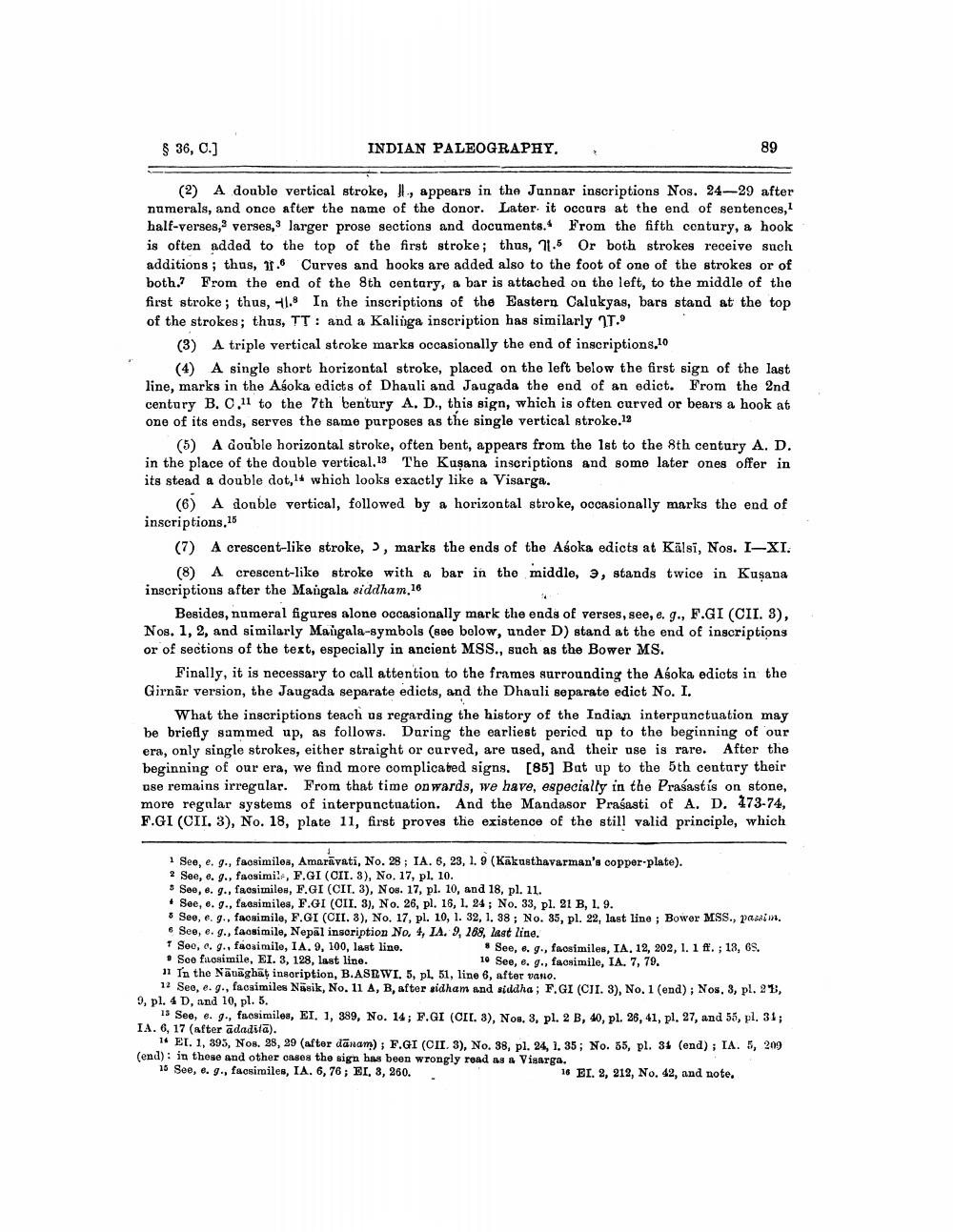________________
$ 36, C.]
INDIAN PALEOGRAPHY,
89
(2) A double vertical stroke, #l., appears in the Junnar inscriptions Nos. 24-29 after numerals, and once after the name of the donor. Later it occurs at the end of sentences, half-verses, verses, larger prose sections and documents. From the fifth century, a hook is often added to the top of the first stroke; thus, 71.5 Or both strokes receive such additions ; thus, 11.6 Curves and hooks are added also to the foot of one of the strokes or of both. From the end of the 8th centary, a bar is attached on the left, to the middle of the first stroke; thus, 1.8 In the inscriptions of the Eastern Calukyas, bars stand at the top of the strokes; thus, TT: and a Kalinga inscription has similarly 11.9
(3) A triple vertical stroke marks occasionally the end of inscriptions.10
(4) A single short horizontal stroke, placed on the left below the first sign of the last line, marks in the Asoka edicts of Dhauli and Jaugada the end of an edict. From the 2nd century B. 0.11 to the 7th bentury A. D., this sign, which is often curved or bears a hook at one of its ends, serves the same purposes as the single vertical stroke.12
(5) A double horizontal stroke, often bent, appears from the 1st to the 8th century A. D. in the place of the double vertical.13 The Kuşana inscriptions and some later ones offer in its stead a double dot, which looks exactly like a Visarga.
(6) A double vertical, followed by a horizontal stroke, occasionally marks the end of inscriptions.15
(7) A crescent-like stroke, ', marks the ends of the Asoka edicts at Kälsi, Nos. I-XI.
(8) A crescent-like stroke with a bar in the middle, 3, stands twice in Kuşana inscriptions after the Mangala siddham.16
Besides, numeral figures alone occasionally mark the ends of verses, see, e. g., F.GI (CII. 3), Nog. 1, 2, and similarly Mangala-symbols (see below, under D) stand at the end of inscriptions or of sections of the text, especially in ancient MSS., such as the Bower MS.
Finally, it is necessary to call attention to the frames surrounding the Asoka edicts in the Girnār version, the Jaugada separate edicts, and the Dhauli separate edict No. I.
What the inscriptions teach us regarding the history of the Indian interpunctuation may be briefly sammed up, as follows. During the earliest pericd up to the beginning of our era, only single strokes, either straight or curved, are used, and their use is rare. After the beginning of our era, we find more complicated signs. [85] Bat up to the 5th centary their use remains irregular. From that time onwards, we have, especially in the Prasastis on stone, more regular systems of interpunctuation. And the Mandasor Prasasti of A. D. 473-74, F.GI (CII, 3), No. 18, plate 11, first proves the existence of the still valid principle, which
i
1 See, e. 9., facsimiles, Amaravati, No. 28 ; IA. 6, 23, 1. 9 (Kākusthavarman's copper-plate). ? See, e. g., facsimil, F.GI (CII. 3), No. 17, pl. 10. 3 See, e. g., facsimiles, F.GI (CII, 3), Nos. 17, pl. 10, and 18, pl. 11. + See, e. g., facsimiles, F.GI (CII. 3), No. 26, pl. 16, 1, 24; No. 33, pl. 21 B, 1. 9. • See, e. g., facsimile, F.GI (CII. 3), No. 17. pl. 10, 1. 32, 1. 38; No. 35, pl. 22, last line; Bower MSS., Pasalin. & See, e. g., facsimile, Nepāl inscription No. 4, IA. 9, 168, last line. + See, c. g., facsimile, IA. 9, 100, last line.
# See, e. g., facsimiles, IA. 12, 202, 1. 1 ff. ; 13, 6S. Soe frosimile, EI. 3, 128, last line.
10 See, e. g., facsimile, IA. 7, 79. 11 In the Nātāghat insoription, B.ASEWI. 5, pl, 51, line 6, after vano.
12 Seo, e. g., facsimiles Näsik, No. 11 A, B, after aidham and siddha; F.GI (CJI. 3), No. 1 (end); Nos, 3, pl. 21, 9, pl. 4 D, and 10, pl. 5.
15 Seo, e. g., frosimiles, EI, 1, 389, No. 14; F.GI (CIL. 3), Nos. 3. pl. 2 B, 40, pl. 26, 41, pl. 27, and 55, pl. 31; IA. 6, 17 (after adadita).
14 ET. 1, 395, Nos, 28, 29 (after dänam); F.GI (CII. 3), No. 38, pl. 24, 1, 35; No. 55, pl. 36 (end); IA. 209 (end): in these and other cases the sign has been wrongly read as a Visarga. 15 See, e. 9., facsimiles, IA. 6,76 ; EI, 8, 260.
16 EI. 2, 212, No. 42, and note.




